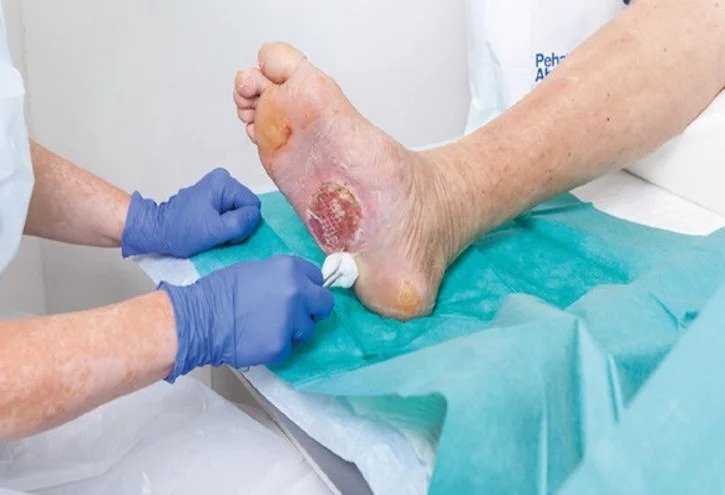The presence of dead or necrotic tissue in the wound bed impedes optimal wound healing. Therefore, adequate wound bed preparation and debridement are considered the cornerstone of treatment in wound care. Several methods of wound debridement are currently available. The selection of the most appropriate debridement method depends on patient factors and local wound characteristics.
What Is Wound Debridement?
Wound debridement refers to the surgical or non-surgical removal of dead, devitalized tissue from the wound surface. Debridement occurs naturally as a part of the healing process. It involves the removal of cellular debris and avascular necrotic tissue from the wound bed by neutrophils and macrophages. However, the gradual buildup of necrotic tissue and cellular debris can place a significant burden on the natural processes. In these situations, wound care specialists and podiatrists need to carry out topical wound bed preparation and debridement. Serial debridements are an essential component of wound management.
Some of the commonly used methods of wound debridement that are currently available include:
- Irrigation: this involves the irrigation of the wound bed with normal saline. Low-pressure irrigation is generally considered adequate for the removal of most foreign material and necrotic tissue from the wound surface.
- Surgical debridement: this method involves the use of sharp surgical instruments for the removal of necrotic tissue. It is considered most appropriate for the removal of large areas of necrotic tissue. It also helps to decrease the bacterial load in the wound bed.
- Enzymatic debridement: this involves the application of exogenous enzymes to the wound bed for the facilitation of debridement. It can be a viable option for patients in which surgical debridement is contraindicated.
- Biological debridement: this novel method involves the use of maggots for the natural debridement of the wound surface. This method has been found to reduce the duration of antibiotic treatment.
Selection of Debridement Method: Factors To Consider
Three basic factors should be considered before the selection of an appropriate wound debridement method. These include:
- General health condition of the patient
- Wound status
- Skill level of the wound care specialist
Some other factors that should also be taken into consideration include:
- Tissue perfusion: low tissue perfusion is considered an absolute contraindication to wound debridement.
- Urgency for debridement: if the need for wound debridement is urgent, surgical methods should be employed.
- Demarcation of nonviable tissue: If nonviable tissue is demarcated, sharp debridement should be done. In case of unclear boundaries, autolytic debridement or enzymatic debridement can be considered.
Patient Condition And Overall Goals of Treatment
The patient's health status, history, and presence of comorbidities affect the selection of an appropriate wound debridement method. For instance, surgical debridement would be unsuitable for patients with clotting disorders. For patients with neutropenia (neutrophil count less than 500), the autolytic method of debridement is considered unsafe. Patients can benefit from enzymatic debridement in this scenario.
It should be kept in mind that if the debridement method goes against the patient's wishes and their overall goal of treatment, the patient has a right to refuse debridement. However, even if complete recovery of the wound is not a goal, debridement can significantly improve infection control and reduce unpleasant wound odor.
As there is always a risk of bacterial release from necrotic tissue debridement, the patient's immune system should also be taken into consideration. Patients with low immunity can develop bacteremia and sepsis.
Wound Status
Some important wound factors that can influence the selection of appropriate wound debridement techniques include infection, tissue perfusion, pain, and the presence of biofilm. In the presence of ulcer-related cellulitis or sepsis, patients can benefit from sharp surgical methods of debridement.
For patients with painful wounds, less painful methods of wound debridement are a viable option. These include autolytic or enzymatic debridement which involves an almost painless removal of dead, necrotic tissue. Ischemic wounds should not be debrided until tissue perfusion has improved. This is because ischemic tissue already has a compromised potential for healing. Further disruption of the wound can result in poor prognosis and outcome.
Skill Level of The Caregiver
Certain wound debridement methods like wound irrigation, autolysis, and enzymatic debridement do not require high expertise and can be carried out even by patients themselves. However, surgical debridement methods are dependent on the manual dexterity and skill level of the caregiver.
Therefore, surgical debridement should only be carried out by highly skilled wound care specialists and podiatrists. In certain scenarios, caregivers might need to provide documentary evidence of their competence.
Wound care providers should operate within their level of competence and scope of practice to avoid medical errors.
It should be kept in mind that a single debridement method is not used at all times. Instead, several methods can be used in combination and then the wound status is reassessed to guide appropriate therapy. Wound care specialists need to be knowledgeable about the various debridement methods available to provide the best possible care to their patients.



.webp)

.avif)